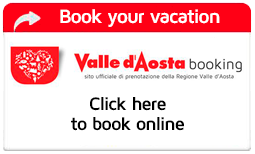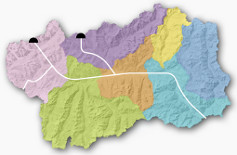Recommendations for hikers
A few rules to help you enjoy your hiking trip in the mountains to the full
ALWAYS: the mountain, by its very nature, presents a number of dangers (falling stones, adverse weather conditions, exposed areas...), so anyone who frequents it must be aware of the risks, and must exercise caution and common sense and adopt all the necessary preventive measures (choosing the appropriate route and equipment, finding out about the weather conditions, etc...).
The high mountain hiking routes can be tackled from July to September.
IN SPRING AND EARLY SUMMER: in shaded areas, at the passes and canyons at medium and high altitudes, there are snowfields that, in the morning or in cold weather, can create difficulty in their crossing (hard snow). It is therefore recommended to adopt appropriate equipment (hiking poles or ice ax, crampons, gaiters ...). Also you can find snowfields covering the the riverbeds that can, if crossed, break suddenly.
AUTUMN-WINTER-SPRING: when there is no snow on the ground, the paths may have icy sections which, although short, must be tackled with the necessary skill, prudence and with adequate equipment (trekking crampons, ...).
If there is snow on the ground, only walk along specifically identified paths, checking their conditions checking the conditions before tackling them: find some itineraries for snowshoe excursions here.
Before setting off
- Consult the weather forecast and check on the conditions and feasibility of the route you have chosen (also on the trails geonavigator). Bear in mind that even in summer you might encounter snow in some areas at altitude which could prove difficult to cross.
- Choose your route according to your physical fitness and technical training. The walking times refer to average trained hikers and stops along the way are not considered: the timing should then be increased by approximately 20% for less experienced hikers;
- Make sure you have a map with the paths marked out, and that you are able to read it properly: these maps will prove an essential guide throughout your trekking trip. To orient yourself, also use a compass, altimeter, GPS.
- Choose rigid frame rucksack with a waist belt so as to spread the weight on your back more evenly;
- Prepare your rucksack carefully, with exactly what you will need. Pack a change of underwear in case you are forced to stop for a while, a waterproof jacket and trousers, carry sunglasses and sun-cream, a first aid kit and enough food and drink for the trip. Make sure the food you take is light, easily digestible and provides plenty of energy.
- Wear waterproof, breathable mountain trekking boots with Vibram type soles and trekking socks with different thickness.
- Use a water bottle or thermos flask to carry liquids: they are more environmentally friendly than plastic bottles, and will keep your drinks at the right temperature.
- Always let someone know the route you intend to follow, especially if you decide to set out alone. Use the books in the huts and bivouacs to indicate the points you have reached along the route.
- Due to the high number of trekkers using the trails, book accommodation along the route in advance, informing hotels and refuges in the event of cancellation;
- If you wish to take guided tours along the trails, please contact the hiking guides associations.
During the trip
- Always set out early. The mountain conditions are often most favourable in the early hours of the day.
- Do not leave marked footpaths for any reason.
- Do not drink stream water, it may not be suitable for human consumption;
- Do not disturb wild animals, Do not feed them biscuits, bread or crackers: these foods do not form part of their diet;
- Avoid picking flowers or mushrooms, collecting minerals or fossils or picking up small creatures such as reptiles, amphibians, etc. All of these are safeguarded by specific environmental protection laws;
- Do not abandon any kind of litter (not even by hiding it beneath stones);
- When you stop for a rest, never leave your rucksack open on the ground: small mountain creatures (such as snakes, vipers, amphibians, etc) could crawl into it, attracted by the smell of food or in search of shelter. On stony ground, watch where you put your hands: it could be home to poisonous creatures such as vipers;
- Do not pitch your tent for the night below 2,500 metres. Regional legislation imposes heavy fines on anyone who breaks this law. It is better to stay overnight in one of the mountain huts in the area; (remember that in the territory of the National Park of Gran Paradiso camping is prohibited even above 2,500 meters and that you can not enter in the territory of the park with dogs).
- Dress “in layers” in order to be able to increase or reduce your clothing according to the temperature;
- Use trekking poles, they enhance your stability and support on all types of terrain. They provide better footing.
In the event of an emergency
- In the event of an emergency, keep calm and avoid reckless actions or rash behaviour that could complicate the situation further. Move to a safe place and shelter yourself from the cold. If you decide to alert the rescue services, make sure you can answer the following questions: who you are; your cellphone number; where you are; what has happened; what the weather conditions are like; whether there are any obstacles that may hinder helicopter rescue.
- In the event of helicopter rescue, as the helicopter approaches, crouch down if you can and keep still until the rescue team has landed. Check that there are no objects in the surrounding area that may be shifted by the airflow of the helicopter blades. If you are unable to alert the rescue services: try to reach a rescue point; move to a safe place and shelter there and launch a visual and/or acoustic signal. In the event of air rescue, prepare the signals to help the helicopter to land.
Signals for helicopter

Acustic and/or visual signalling
- Call 1 signal every 10 seconds for one minute
- Reply 1 signal every 20 seconds
The signals should be repeated at one-minute intervals. Use colourful materials to draw attention to yourself.
USEFUL NUMBERS
- Emergencies - tel. 112
- Civil defence - tel. 800 319 319
- Bus station (Aosta) - tel. (+39) 0165 262027














